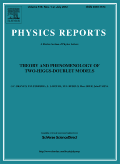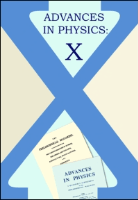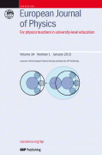
PHYSICS REPORTS-REVIEW SECTION OF PHYSICS LETTERS
Scope & Guideline
Advancing the frontiers of physics knowledge.
Introduction
Aims and Scopes
- Interdisciplinary Research in Physics:
The journal publishes articles that bridge the gap between physics and other scientific disciplines, particularly biology and material sciences, showcasing the application of physical principles to solve complex biological problems. - Methodological Innovations:
A consistent emphasis is placed on new methodologies and experimental techniques that enhance research capabilities in physics-related fields, including computational modeling, molecular dynamics, and novel imaging techniques. - Focus on Biological Systems:
Research articles increasingly focus on the physical principles underlying biological systems, such as cellular mechanics, biophysics of biomolecules, and the interactions between biological and physical entities. - Health and Disease Applications:
The journal highlights studies that apply physics principles to health and disease, including drug delivery mechanisms, cancer research, and the impact of physical factors on biological processes. - Materials Science and Nanotechnology:
Research on novel materials and nanotechnology is prominent, with articles exploring the physical properties of materials and their applications in various fields, including medicine and environmental science.
Trending and Emerging
- Biophysics and Cellular Mechanics:
A growing number of articles are exploring the physical mechanisms underlying biological processes at the cellular and molecular levels, indicating a trend towards integrating physics with biological research. - Nanotechnology and Materials Science:
There is an upward trend in research focusing on nanomaterials and their applications, particularly in drug delivery systems, tissue engineering, and biosensing technologies. - Computational and Data-Driven Approaches:
The use of computational methods and data analysis techniques in physics research is on the rise, with an emphasis on machine learning and artificial intelligence as tools for modeling complex systems. - Interdisciplinary Health Applications:
Emerging research themes emphasize the application of physics in health sciences, particularly in cancer treatment, diagnostics, and the development of therapeutic technologies. - Environmental Physics:
Research addressing the physical aspects of environmental challenges, such as climate change, pollution, and sustainable materials, is gaining prominence, showcasing the journal's commitment to addressing global issues.
Declining or Waning
- Traditional Physics Topics:
There has been a noticeable reduction in papers focused solely on traditional physics topics, such as classical mechanics or thermodynamics, as interdisciplinary approaches gain more traction. - Purely Theoretical Studies:
The journal has seen fewer purely theoretical physics papers, as the emphasis shifts towards experimental validation and applications in real-world scenarios. - Focus on Basic Sciences:
Research focusing exclusively on basic science without direct application to technology or health has declined, as the journal prioritizes studies with tangible impacts. - Limited Coverage of Historical Studies:
Articles that delve into the historical aspects of physics, such as the history of physics theories or historical experiments, have become less frequent, reflecting a shift towards contemporary research.
Similar Journals

Ukrainian Journal of Physics
Unveiling New Discoveries in Physics and AstronomyUkrainian Journal of Physics, published by the Bogolyubov Institute for Theoretical Physics of the National Academy of Sciences of Ukraine, stands as a significant platform for the dissemination of research in the dynamic field of physics. With its ISSN 2071-0186 and E-ISSN 2071-0194, the journal aims to foster academic dialogue and innovation among researchers, professionals, and students alike. Recognized with a Scopus ranking that places it in the 26th percentile, the journal offers an array of contributions spanning various domains, including general physics and astronomy. Although currently categorized in the Q3 quartile for 2023, it seeks to elevate its scholarly impact while providing open access to its contents, facilitating wider availability and engagement. With a commitment to publishing high-quality research from 2007 to 2024, the journal embraces interdisciplinary approaches to physics, making it an invaluable resource for anyone dedicated to advancing their understanding and exploration of physical sciences.

TECHNICAL PHYSICS
Exploring Innovations in Theoretical and Applied PhysicsTECHNICAL PHYSICS, published by PLEIADES PUBLISHING INC, is a prestigious journal that has been serving the scientific community since its inception in 1996. With a focus on the diverse realms of physics and astronomy, this journal is committed to publishing pioneering research that spans various aspects of theoretical and applied physics. Though currently categorized in the Q3 quartile for the year 2023, TECHNICAL PHYSICS holds considerable merit with a Scopus ranking of #56 out of 81 in its field, positioning it within the 31st percentile. The journal aims to provide a platform for researchers, professionals, and students to disseminate their findings and foster collaboration within the global physics community. While it does not currently offer open access, the journal remains a vital resource for those seeking to stay informed of the latest advancements and trends in technical physics. Based in the heart of New York, it continues to contribute to the evolution of this dynamic field.

Frontiers of Physics
Transforming Theoretical Insights into Practical AdvancementsFrontiers of Physics, published by Higher Education Press, is a premier open-access journal dedicated to fostering innovative research and excellence within the field of physics. With an ISSN of 2095-0462 and an E-ISSN of 2095-0470, this rapidly growing journal has established itself as a valuable platform for disseminating cutting-edge findings, covering a diverse range of topics from theoretical frameworks to experimental advancements. Notably, Frontiers of Physics has achieved an impressive Q1 ranking in the 2023 Scopus Quartiles for Physics and Astronomy, securing a competitive 5th out of 81 positions in its category, reflecting a high impact factor that underscores its importance to the scientific community. Since its inception in 2011 and continuing through 2024, the journal aims to bridge the gap between academia and industry, encouraging collaboration among researchers, professionals, and students alike. Its commitment to open access ensures that high-quality research is readily accessible, thereby promoting knowledge sharing and advancement in the global physics community. Explore the potential of your research in Frontiers of Physics, where the future of physics flourishes.

JOURNAL OF BIOLOGICAL PHYSICS
Exploring the Synergy of Life and MatterThe JOURNAL OF BIOLOGICAL PHYSICS, published by Springer, is a premier interdisciplinary journal that focuses on the intersection of biological sciences and physics. With an ISSN of 0092-0606 and an E-ISSN of 1573-0689, this journal serves as a significant platform for researchers and professionals to publish innovative studies, covering fields such as atomic and molecular physics, biophysics, cell biology, and molecular biology. The journal has been a key player since its inception in 1973, showcasing rigorous scientific inquiry and advancing knowledge within these domains, reflected in its categorization in the Q3 and Q4 quartiles of various relevant fields as of 2023. While it currently operates without an Open Access model, the journal continues to provide pivotal contributions to its audience, supporting academic and practical advancements in biological physics while engaging a broad scope of scholarly discourse.

Advances in Physics-X
Catalyzing Collaboration for Groundbreaking DiscoveriesAdvances in Physics-X is a premier open-access journal published by Taylor & Francis Ltd, dedicated to advancing the frontiers of knowledge in the field of Physics and Astronomy. Since its inception in 2016, the journal has established itself as a vital platform for researchers and professionals, showcasing innovative research and cutting-edge theories that influence a broad array of sub-disciplines within physics. With an impressive impact factor and ranked in the 94th percentile among its peers, it resides in the Q1 category for Physics and Astronomy (miscellaneous), indicating its significant contributions to the academic community. Located in the United Kingdom, the journal encourages open access to foster wider dissemination and visibility of scholarly works, aligning with contemporary academic trends that prioritize global knowledge sharing. The ongoing commitment to publishing high-quality research ensures that Advances in Physics-X remains an essential resource for students, industry experts, and academics alike, helping to shape the future of physics research through collaboration and innovation.

Science China-Physics Mechanics & Astronomy
Advancing Knowledge in Physics and AstronomyScience China-Physics Mechanics & Astronomy, published by SCIENCE PRESS, stands as a prestigious journal within the Physics and Astronomy domain, particularly recognized for its contributions to the understanding of fundamental and applied physics. With an exhilarating Q1 ranking in the 2023 category and earning a remarkable scopus rank of #21 out of 243, the journal demonstrates its significant impact, being positioned in the 91st percentile of its field. Operating under an Open Access model, it facilitates the broad dissemination of high-quality research, ensuring accessibility for researchers, professionals, and students worldwide. Its scope covers a variety of essential topics in physics and astronomy, promoting a comprehensive understanding of the latest advancements from 2010 through 2024. The journal is a vital resource for anyone aiming to stay at the forefront of research in these dynamic fields, with its prominent address located in Beijing, China, symbolizing its global influence.

Lithuanian Journal of Physics
Bridging Gaps in Physical Science UnderstandingWelcome to the Lithuanian Journal of Physics, an esteemed publication helmed by the Lithuanian Physical Society, dedicated to advancing the field of physics and astronomy. Established in 2008 and continually publishing insightful research through 2024, this journal aims to provide a platform for high-quality scholarly articles that contribute to the understanding of various physical phenomena. With a steady presence in the academic landscape, the journal is currently ranked in the fourth quartile of the Physics and Astronomy category and is positioned at the 18th percentile in its Scopus ranking, reflecting its niche focus and accessibility for researchers and students alike. Although currently not operating under an open access model, the journal remains a vital resource for professionals seeking to stay informed on the latest developments in the field. The Lithuanian Journal of Physics invites contributions that inspire collaboration and innovation in physical sciences, making it an invaluable resource for the global scientific community seeking to expand knowledge within this dynamic field.

Bulletin of the Lebedev Physics Institute
Fostering innovative discussions in the realm of science.Bulletin of the Lebedev Physics Institute is a peer-reviewed journal dedicated to advancing the field of physics and astronomy, published by PLEIADES PUBLISHING INC. With a print ISSN of 1068-3356 and an e-ISSN of 1934-838X, this journal has been an essential platform for disseminating significant research findings since its inception in 2009. It continues to provide insight into various areas of general physics and astronomy, and consistently aims to foster innovative discussions among researchers and scholars. Although currently positioned in the Q4 category within the 2023 Scopus rankings, it serves a vital role in linking emerging trends with established research, catering to a global audience seeking to explore complex concepts within the field. By contributing to the body of knowledge, the Bulletin supports academic growth and collaboration across diverse sectors. Despite its challenges in ranking, the journal’s unique perspectives and ongoing publications underscore its commitment to pushing the boundaries of scientific inquiry in the United States and beyond.

MOMENTO-Revista de Fisica
Exploring Interdisciplinary Insights in ScienceMOMENTO-Revista de Fisica is a distinguished academic journal published by UNIV NACL COLOMBIA, FAC SCI, based in the vibrant academic landscape of Colombia. With an ISSN of 0121-4470 and an E-ISSN of 0121-4470, this Open Access journal has been a pivotal platform for disseminating research since its shift to Open Access in 2012. It primarily serves researchers, professionals, and students interested in a diverse range of fields such as Electronic, Optical and Magnetic Materials, Geophysics, History and Philosophy of Science, and Physical and Theoretical Chemistry. With an evolving focus that spans from 2019 to 2024, MOMENTO contributes significantly to the understanding of contemporary challenges and advancements in physics and its interdisciplinary applications. Despite its current Q4 rankings in several categories and Scopus rankings indicating growth areas, the journal plays a crucial role in nurturing a scholarly dialogue in less represented topics within the sciences. By bridging gaps in knowledge and fostering new ideas, MOMENTO-Revista de Fisica continues to attract authors and readers committed to pushing the boundaries of research.

EUROPEAN JOURNAL OF PHYSICS
Empowering Scholars with Rigorous InsightsEuropean Journal of Physics, published by IOP Publishing Ltd, is a premier international journal serving the diverse field of physics and astronomy. With a commitment to advancing scientific knowledge since its inception in 1980, the journal provides a platform for original research articles, reviews, and topical discussions in various domains, including theoretical and experimental physics. Operating out of the United Kingdom, the journal has achieved a commendable Q2 ranking in the Physics and Astronomy (miscellaneous) category for 2023, reflecting its robust influence in the academic community, alongside a notable Scopus Rank that underscores its relevance in both the Social Sciences and General Physics and Astronomy fields. Although it does not currently offer open access, the journal's traditional publication model ensures rigorous peer review, maintaining high scholarly standards that are imperative for researchers, professionals, and students striving to stay ahead in their respective fields. Don't miss the opportunity to engage with cutting-edge research and contribute to the ongoing dialogue in physics by accessing this vital resource.